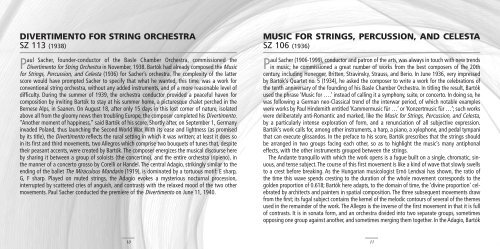LES VIOLONS DU ROY :: JEAN-MARIE ZEITOUNI ATMA Classique
LES VIOLONS DU ROY :: JEAN-MARIE ZEITOUNI ATMA Classique
LES VIOLONS DU ROY :: JEAN-MARIE ZEITOUNI ATMA Classique
- No tags were found...
You also want an ePaper? Increase the reach of your titles
YUMPU automatically turns print PDFs into web optimized ePapers that Google loves.
DIVERTIMENTO FOR STRING ORCHESTRASZ 113 (1938)Paul Sacher, founder-conductor of the Basle Chamber Orchestra, commissioned theDivertimento for String Orchestra in November, 1938. Bartók had already composed the Musicfor Strings, Percussion, and Celesta (1936) for Sacher’s orchestra. The complexity of the latterscore would have prompted Sacher to specify that what he wanted, this time, was a work forconventional string orchestra, without any added instruments, and of a more reasonable level ofdifficulty. During the summer of 1939, the orchestra conductor provided a peaceful haven forcomposition by inviting Bartók to stay at his summer home, a picturesque chalet perched in theBernese Alps, in Saanen. On August 18, after only 15 days in this lost corner of nature, isolatedabove all from the gloomy news then troubling Europe, the composer completed his Divertimento.“Another moment of happiness,” said Bartók of his score. Shortly after, on September 1, Germanyinvaded Poland, thus launching the Second World War. With its ease and lightness (as promisedby its title), the Divertimento reflects the rural setting in which it was written; at least it does soin its first and third movements, two Allegros which comprise two bouquets of tunes that, despitetheir peasant accents, were created by Bartók. The composer energizes the musical discourse hereby sharing it between a group of soloists (the concertino), and the entire orchestra (ripieno), inthe manner of a concerto grosso by Corelli or Handel. The central Adagio, strikingly similar to theending of the ballet The Miraculous Mandarin (1919), is dominated by a tortuous motif: E sharp,G, F sharp. Played on muted strings, the Adagio evokes a mysterious nocturnal procession,interrupted by scattered cries of anguish, and contrasts with the relaxed mood of the two othermovements. Paul Sacher conducted the première of the Divertimento on June 11, 1940.MUSIC FOR STRINGS, PERCUSSION, AND CE<strong>LES</strong>TASZ 106 (1936)Paul Sacher (1906-1999), conductor and patron of the arts, was always in touch with new trendsin music; he commissioned a great number of works from the best composers of the 20thcentury, including Honegger, Britten, Stravinsky, Strauss, and Berio. In June 1936, very impressedby Bartók’s Quartet no. 5 (1934), he asked the composer to write a work for the celebrations ofthe tenth anniversary of the founding of his Basle Chamber Orchestra. In titling the result, Bartókused the phrase ‘Music for ….’ instead of calling it a symphony, suite, or concerto. In doing so, hewas following a German neo-Classical trend of the interwar period, of which notable exampleswere works by Paul Hindemith entitled ‘Kammermusic für …’ or ‘Konzertmusic für …’; such workswere deliberately anti-Romantic and marked, like the Music for Strings, Percussion, and Celesta,by a particularly intense exploration of form, and a renunciation of all subjective expression.Bartók’s work calls for, among other instruments, a harp, a piano, a xylophone, and pedal tympanithat can execute glissandos. In the preface to his score, Bartók prescribes that the strings shouldbe arranged in two groups facing each other, so as to highlight the music’s many antiphonaleffects, with the other instruments grouped between the strings.The Andante tranquillo with which the work opens is a fugue built on a single, chromatic, sinuous,and tense subject. The course of this first movement is like a kind of wave that slowly swellsto a crest before breaking. As the Hungarian musicologist Ernö Lendvai has shown, the ratio ofthe time this wave spends cresting to the duration of the whole movement corresponds to thegolden proportion of 0.618; Bartók here adapts, to the domain of time, the ‘divine proportion’ celebratedby architects and painters in spatial composition. The three subsequent movements drawfrom the first; its fugal subject contains the kernel of the melodic contours of several of the themesused in the remainder of the work. The Allegro is the inverse of the first movement in that it is fullof contrasts. It is in sonata form, and an orchestra divided into two separate groups, sometimesopposing one group against another, and sometimes merging them together. In the Adagio, Bartók1011
















